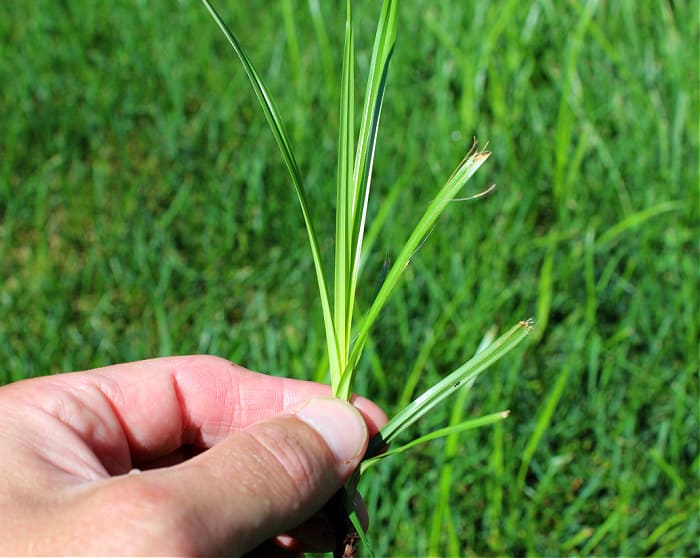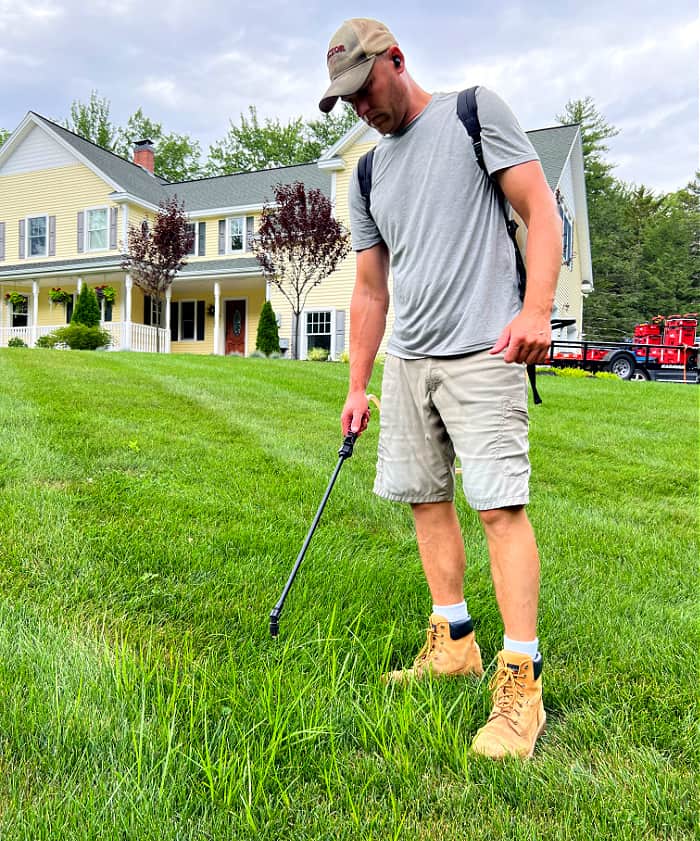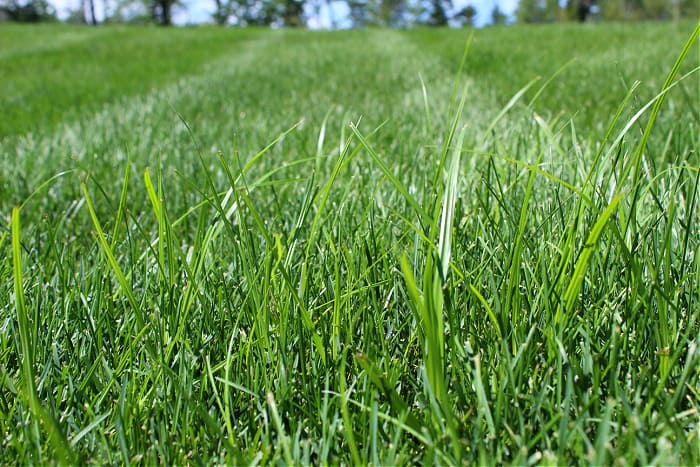Nutsedge is an aggressive lawn weed that can take over your lawn in the mid summer months. Follow these tips to get rid of Nutsedge and keep it from coming back.
What Is Nutsedge
Nutsedge, also known as Nutgrass, is a common perennial lawn weed found throughout the world. There are two types of Nutsedge, Yellow and Purple. Yellow Nutsedge typically grows in mid summer, and if left alone will develop a yellow flower. Purple Nutsedge grows in late summer/early fall and will grow a purple flower if left alone. Despite their slight differences, they are equally a nuisance to those who want a uniform, weed free lawn.
Nutsedge belongs to the ‘Sedge’ family and are very different then other lawn weeds. These differences make sedges difficult to control with common lawn safe herbicides. However, specialty products are effective and will get rid of Nutsedge.
How to Identify Nutsedge
Although Nutsedge is a green, grassy weed, it can actually be pretty easy to identify among your other grasses:
1. Generally it is light green (although purple nutsedge me be darker) with shiny, smooth leaves. The leaf blade is divided in half by a mid rib, or vein, that runs through the blade.
2. One of the easiest ways to identify nutsedge is it’s height and rapid growth rate. Nutsedge will usually grow taller, and much faster than the rest of your lawn, causing it to stand out. Also, you may notice nutsedge in wetter areas, or areas where there is poorly drained soil.
3. Lastly, and probably the easiest way to identify Nutsedge is to look a it’s stem near the base of the plant. You’ll see a ‘fan like’, triangular shape as seen below:

How Does Nutsedge Spread
You’re probably wondering how Nutsedge got into your yard to begin with. There are 3 ways Nutsedge spreads and can become established in your lawn:
1. Seed- Nutsedge can enter your lawn via seed. After the flowering stage the plant goes to seed and the seed can blow into your lawn or be transported through animal life or through soil that you purchase and spread into your lawn.
2. Rhizomes- Nutsedge has a spreading habit through underground rhizomes. Rhizomes allow the plant to branch out and spread and fill in bare spots in your lawn.
3. Underground Tubers- In addition to rhizomes, Nutsedge spreads through underground tubers known as ”nutlets”. These nutlets can be deep in the soil (6”-18”) and their depth is one of the reasons Nutsedge is so hard to control with common herbicides. These nutlets are also the reason you want to avoid pulling Nutsedge as a method for control. Pulling Nutsedge can actually activate the nutlets and cause them to put out new growth.
How to Get Rid of Nutsedge
The best way to get rid of Nutsedge is with a liquid, lawn safe herbicide. There are a couple of products to choose from, but here are some personal favorites:
Sedgehammer + (Halosulfuron-methyl 5%) can be purchased in powder form or in a liquid concentrate. The powder is a great inexpensive option. You simply mix one packet in one gallon of water, in a tank sprayer or hose end sprayer (I prefer tank sprayers and have a 4 gallon back pack sprayer, but you can get small 2 gallon pump sprayers for cheap), and that should be enough to treat 1000 s/f. I recommend getting a couple of packets sense you may have to do a follow up application 3-4 weeks later. Remember to be patient when using this product sense it is a systematic herbicide and works by moving through the cells of the plant. You won’t see any real effects until 10-14 days after application.

One of the great perks about Sedgehammer is it’s safe for most cool season and warm season lawns, (but always read label). Also, with the packet of Sedgehammer + you don’t have to add surfactant since it already contains it. Surfactant is an additive that helps the herbicide stick to the plant.
Another option for getting rid of Nutsedge that is more convenient is Ortho Nutsedge Killer (active ingredient Sulfentrazone 0.05%). You’re very likely to find this product at your local big box store. It’s easy to use with clear instructions on the label. You can either use the hose end sprayer which means you simply attach the bottle to your hose, or you can use the spray bottle option which is great for smaller infestations.
Prevent Nutsedge
The best way to prevent Nutsedge is to maintain a healthy, well fed lawn, using an easy and effective lawn care program. Also following good mowing practices will strengthen turf and allow your desirable grasses to block Nutsedge from invading.
Reducing compaction and amending clay soil can also help in water and nutrient uptake which will benefit your grass.
Lastly, early intervention is so much easier so treat your Nutsedge problem early on before the Nutsedge becomes mature and established.
FAQ
– Should you pull Nutsedge?
Pulling Nutsedge is not the best idea. Pulling nutsedge can actually send a signal to the underground tubers to spread and put out new growth. While persistent pulling over time can weaken the plant, it is most likely to do more harm then good.
– Will Pre-emergents prevent Nutsedge?
Technically pre-emergents will prevent Nutsedge growing from seed, but sense Nutsedge is a perennial weed and spreads through underground tubers and rhizomes, it will not prevent Nutsedge from coming back every year if you already have it in your lawn.
– Can you kill Nutsedge organically?
There’s certainly not a perfect way to control Nutsedge organically. You can try pulling the weeds as you see them but you have to be extremely persistent since hand pulling can actually cause the weed to grow more before eventually starting to die back. Your best bet to control nutsedge organically is to maintain a healthy, well fed lawn, and fix problems such as soil compaction and drainage where nutsedge is likely to thrive.
Pro Tips
- When applying lawn safe, post emergent herbicides like Sedgehammer, apply the product at least 2 days after mowing, and wait at least 2 days before mowing again.
- Apply herbicides when lawn is dry, and preferably in the morning. Don’t apply when temperatures are above 85 degrees or when your lawn is stressed or in dormancy.
- Make sure the herbicide has at least 4 hours to dry before getting wet.
Check Out These Posts Next
Lawn Care Schedule Using Only 3 Products
The Importance of Soil Temperature In Your Lawn
How to Kill Weeds Without Killing Grass
Top Dressing Lawn: Benefits and Advice
Follow Me
Join my free email list!





This is so helpful! I have this throughout my lawn and I always wondered what it was and how to get rid of it. Thank you so much for these wonderful tips!
You’re very welcome Brenda, good luck!
As soon as we’ve finished our other projects, I want to implement your program. There is nothing nicer than a beautiful lawn.
Janice
I love that idea Janice, and I agree!
Hi Mark, Just a suggestion! I think a photo ID list of the weeds that affect our lawns would be helpful! Many thanks for all the education your newsletter offers. Sincerely, Charles from Boston
Hay Mark where can i purchase sedgehammer product ?
i thank you for all your helpful advice.
Paul Kapela
Hi Mark. I’m desperate! We had a national lawn care service for two years. They got broadleaf weeds killed. However, we have major moss problems over yard and driveway. I don’t know what to do first in getting it under control. It’s spring here in Washingto state and moss is thriving! HELP
Hi Helen… Moss is such a tough topic to cover since there’s so much to consider. I would start ultimately by asking yourself why is your lawn covered in moss? Are you in the shade, is your lawn constantly wet, maybe it’s underfed, compacted soil, poor drainage. Maybe it’s a combination of all those things. Plenty of things can be done to improve overall conditions such as trimming or removing trees and also improving soil conditions by core aeration, top dressing with compost, and then overseeding. Also liquid aeration is a great thing to add into your lawn maintenance if you have compacted soil. But the other thing to consider is the time of year. Core aeration, top dressing, and seeding for example is best in the late summer early fall. So if I were you I’d focus on some better options since it’s spring. Start by doing your best to weaken the moss by using a product like Moss Ex. Then you can rake up the dead moss or even better, rent a power rake dethatcher to do a light dethatching. This will help get rid of the moss and get some airflow along the surface of the soil. Then, put down your pre emergent and fertilize. Keep your lawn well fed throughout the season and in the early fall you can pull the trigger on core aeration, top dressing with compost, and overseeding if needed.